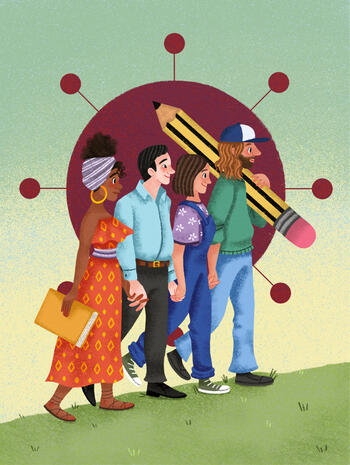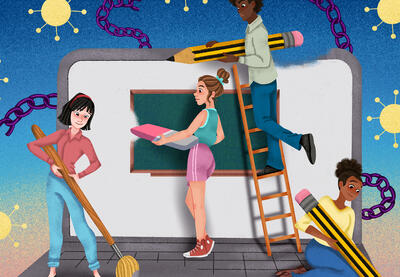“[The pandemic] is a portal,” wrote novelist Arundhati Roy in April 2020, “a gateway between one world and the next.” Last fall, soaring coronavirus rates cast a pallor over back-to-school season. As school doors shuttered, communities left behind their familiar worlds of in-person learning.
At first, the uptick in professional learning Zoom workshops, online lectures and virtual self-guided learning opportunities grew out of necessity. But in time, educators discovered an untapped wellspring of opportunities for greater equity and access. Almost overnight, online sessions reached educators not just in urban centers but also those in isolated regions and with limited mobility. Some had previously thought attending in-person training impossible. “Having an opportunity to take an [LFJ] PD is a dream come true,” wrote one Learning for Justice professional learning participant in a post-session survey. “I would never be able to take time off to travel to a larger city to attend an in-person workshop.”
Facilitators and trainers had begun imagining a new world. This world contained breathing room to contemplate the meaning of liberatory education. In this new world, educators adapted schooling and training for remote platforms—and in the process, redrew the boundaries of learning.

Expansion Brings Access
The rise in virtual options meant many educators at schools with limited economic resources no longer had to contend with their communities’ competing priorities for anti-bias trainings. Learning for Justice Professional Development Manager Sarah-SoonLing Blackburn reflects on her time as a classroom teacher and how professional learning couldn’t compete as a priority for her school. “My classroom used to flood every time it rained,” she remembers. “So, [the administration] isn’t thinking about, ‘OK, what great social justice training can we get for people?’ They’re like, ‘How do we use our budget to fix this roof that’s been leaking for five years?’”
Many under-resourced schools with high teacher turnover rates reserve professional development for foundational teaching skills. However, with widespread remote access, educators could design their own professional learning priorities. Cornelius Minor, a Brooklyn-based literacy coach, says last year he engaged in the most professional learning of his entire career. “People can select the professional learning they want and [access] it à la carte, for free,” he says. “It’s really democratized professional learning.”
Increased accessibility doesn’t only benefit those on the margins. When more people can access a space or conversation, everyone’s experience improves. Disability activists dubbed this phenomenon the “curb-cut effect,” after the sidewalk aprons they advocated for aided pedestrians at all ability levels. Civil rights advocate Angela Glover Blackwell later applied the term more broadly, and educators have observed it in this past year’s virtual shifts in professional learning.
Blackburn and LFJ Professional Learning Facilitator Kimberly Burkhalter witnessed the curb-cut effect in their virtual sessions, when an adaptation intended for a minoritized group brought benefit to all. To better serve attendees with hearing loss, they began using Google Slides’ automatic closed captioning in their sessions. While the facilitators initially did this solely for a particular group, educators without hearing loss reported on how helpful they found the feature. The pandemic’s constraints allowed them to spot gaps in their sessions’ accessibility they may not have known otherwise.
Virtual learning has likewise borne fruit in the social realm. In virtual sessions, attendees can forge connections outside of their usual spheres. Meeting thought partners from different professional contexts brings fresh perspectives and insights. Social justice educators feeling isolated can find solidarity grounded in shared passion.
“Some educators feel really attacked in doing the work, and it’s reassuring to them to know that there are other educators who are doing the same work and support them,” notes Blackburn. “It helps remove some of that self-doubt that starts to creep in, because if you feel like you’re the only one, you’re like, ‘Maybe I’m wrong. Maybe what I’m doing isn’t the right thing.’”
While building robust virtual community is possible, it does require the right conditions and thoughtful design. Educators need reliable internet access to participate. And without the ease of face-to-face networking, facilitators must foster a shared sense of purpose. With Zoom fatigue and the ease of going off-camera, it can be difficult to tell how participants are engaging.
To prevent this pitfall, facilitators can accommodate a broad spectrum of learning styles using uniquely virtual features like chat and breakout rooms. “I loved learning the capabilities of an engaging Zoom,” wrote one LFJ session participant. “This is new to us. Annotating, breakout groups, the poll idea, it was all very engaging and added to the training.”
“Love this as a model of digital learning,” wrote another. “Chat, short video, breakout groups. All effective ways of engaging! These are the qualities of the meetings which lend themselves to retaining my attention.”
From Isolation to Invention
For education consultant shea martin, social distancing only intensified the inherent isolation in their daily work, and they attribute this isolation to taking up the work of an anti-bias educator. “A lot of times,” martin says, “when we are teaching or working and doing really difficult work that’s pushing back against systems, it can be a very isolating experience in general. And so this increased isolation was just really hard.” martin sought solace remotely, reaching out to friends and colleagues Kass Minor, Elizabeth Kleinrock and Kelly Wickham Hurst. They brainstormed solutions and, soon thereafter, Liberate and Chill* was born.
Liberate and Chill* operated as a virtual collective for equity, justice and anti-bias, anti-racist (ABAR) education—a collective that has grown since that early outreach among friends. Its mission employed three key principles: learning, community and continuity.
“The first goal was to ensure that people and teachers were still getting quality anti-bias, anti-racist professional development during this time,” martin explains. “The other piece was to encourage and create community networks of care online. And the third was to ensure that the people who’ve committed their lives to this work, like consultants, are able to keep the lights on.”
Liberate and Chill* offered modules on ABAR education, 10 Q&As with social justice educators, a BIPOC affinity space, an LGBTQ brunch, community groups like “knit and nurture,” and open conversations about education and justice. Hundreds of participants gathered on Sunday nights to lesson plan together, splitting off into subject area breakout rooms, then coming back together for video gaming, fiber arts lessons and the reassurance of community.
“It became huge almost overnight,” remembers Cornelius Minor. “There were hundreds of teachers coming together. That really taught us that people want to study beyond what their schools are giving them.”
The collective’s success demonstrated an important fact: Physical proximity is not a prerequisite for solidarity. In fact, when communities drop the expectation of geographical closeness, rarely centered experiences and identities can come to the fore.
For those with historically oppressed identities, this presents a precious opportunity, as seeing oneself mirrored in others is already too rare. In this way, virtual community provides an oasis for soaking in safety and connection.
“Rarely ever am I in spaces with all of my people,” Cornelius Minor says. “That was a really cool aspect of it—where there was no need for the cultural translation work that has to happen, where we could just be. Even if we weren’t doing school stuff, we could just be.”
As soon as the pandemic hit, there has been this really toxic discourse about, ‘When are we going to get back to normal?’ And that normal that we left behind left far too many people at the margins.
— Cornelius Minor
Radical Dreaming
COVID undeniably shook the social fabric of school communities to their core. And yet, there’s more to the story. Concurrent with the trauma and grief, the pandemic created openings for educators like martin to dream boldly.

When stay-at-home orders took effect, martin hit the ground running. They teamed up with colleagues to create a public space for Black educators to gather after the murder of George Floyd. They started a Padlet project for educators to process their experiences through creative writing. They also did a lot of thinking with colleague Cody Miller about queer kids who may be struggling at home.
“As soon as the pandemic hit and we knew that we were going to be at home for a while,” martin recalls, “Cody and I had a conversation. ... For some kids, school is their safe space and maybe home isn’t a place where they can be out or themselves. And so I spent a lot of the early pandemic being worried for some kids who are not out, some kids who rely on teachers or friends to really be that network that shows them family.”
In September 2020, the two teamed up to start Love and LiteraTea, an online book club for LGBTQ youth to read literature featuring and penned by LGBTQ people. Over 200 students in grades 8-12 meet biweekly in three cohorts for online discussion about the readings. The students run the Love and LiteraTea social media account, and authors join meetings to talk with students about the books they’re reading.
The pandemic left many queer students isolated; for others, it only magnified a chronic sense of vulnerability and aloneness. By supporting LGBTQ youth to connect regardless of location, Love and LiteraTea reached so many of them.
Freed From the Mold
Virtual education disentangles learning from the confines of the physical classroom. It allows marginalized students and educators to connect in supportive learning environments. “There are kids who say they feel safer learning from home,” reflects Blackburn. “And I think that is something we should honor in multiple ways. If you feel like you’re an outsider because of your interests or identity, you want to go to a school where there are other kids like that, where you don’t feel like such an outcast every single day and where you recognize that the world has a place for you.”
When it comes to traditional in-person learning, social justice educators agree: There’s no going back. Instead of returning to the status quo, they intend to keep reimagining how to best reach their students. Educators like Cornelius Minor celebrate this as a profoundly positive shift.
“As soon as the pandemic hit, there has been this really toxic discourse about, ‘When are we going to get back to normal?’ And that normal that we left behind left far too many people at the margins,” Minor reflects. “That is not a normal I want to return to. That normal was not OK if you’re poor. That normal was not OK if you’re queer. That normal was not OK if you’re Black or Brown.
“I’m all about thinking about, ‘What can we create?’ Blank canvas, brand new paints. What can we create moving forward? What can we create for students? What can we create for ourselves?”
Thinking Outside the Classroom Walls
Educators have responded to the pandemic’s limitations by constructing brand new avenues for collaboration. For Cornelius Minor, remote learning has allowed him to expand the boundaries of schooling itself, as class sessions were no longer confined to the four walls of a room.
Last summer, with indoor gatherings prohibited, Minor and his partner in all things, Kass, taught in parks and on street corners in socially distanced groups of four. “Rich kids were doing that; their parents were paying for pods,” Minor recalls. “But we’re like, ‘Who’s in the hood doing that? Can we, in the neighborhood, convene groups of people to study nature or to study really cool books?’ And there were people who were like, ‘You can’t do that. That’s not what school is. School isn’t outside on a corner.’ And we’re like, ‘Who said?’”
Teaching virtually, Minor traversed time zones to visit peers’ virtual classrooms. When he struggled through teaching a particular concept, a friend offered to drop into his virtual class so they could go through it together. “Now I go to people’s classes,” he says, “and I’m like, ‘Hey, how’d you do that book with your kids?’ And I’ll literally be in there with them and their kids, and we’ll be doing the book together. Then I run back to my Zoom room and I’m like, ‘All right, here’s how I just saw my friend do it, so here’s how I can do it.’ Professional learning doesn’t have to be a proper noun.”

